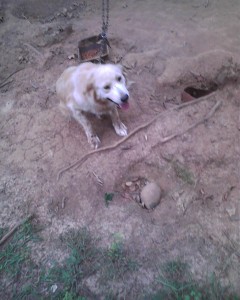Tethering is the practice of fastening a dog to a stationary object or stake, usually on the owner’s property, for months and even years. A friendly, social dog who is chained for long periods of time becomes aggressive and a nuisance. The area within the confines of his chain because his “territory” and he will protect this area when he feels threatened. He is unable to run from the threat (which can be something as innocent as a child walking up to him to pet him) and will therefore attack.
A chained dog is an easy target for attacks by other animals, humans and biting insects. An insensitive human may tease the dog or throw objects at him. Mosquitos will bite these animals, which leads to heartworm infection in the dog, eventually leading to death if not treated.
Chains and ropes can become tangled around objects in their path. This can lead to the dog choking to death or the collar becoming embedded in the dog’s neck.
A dog that is chained for most of its life is not a “member of the family” and gives no joy to the owner. Many times, they are forgotten and go for long periods of time without food or water. Their area can also lack proper shelter and, therefore, expose him to severe hot and cold weather with no protection. The involved area is also when the dog must go to the bathroom, which means he is living in unsanitary living conditions.
LAW is against tethering/chaining and seeks to eliminate it through education and providing information about alternate means of confinement, if necessary. LAW recommends dogs living inside with the family but, if this is not possible, support s the use of proper fencing and shelter. LAW will assist pet owners with planning and area for their dog, if needed.
